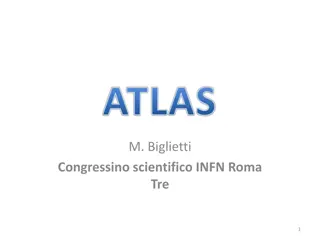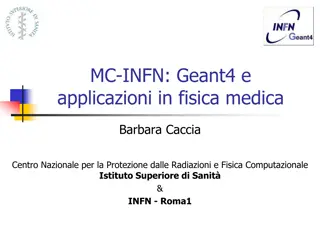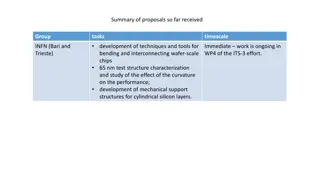
Latest Trends in Hardware Technology for High-Energy Physics Computing
Explore the emerging trends in hardware technology for high-energy physics computing discussed at the Workshop sul Calcolo nell'INFN. Discover insights on semiconductor industry advancements, processing units, memory and storage technologies, as well as future prospects for capacity increase and technology awareness. Stay informed about the evolving landscape of computing needs and budget constraints in the field of high-energy physics.
Download Presentation

Please find below an Image/Link to download the presentation.
The content on the website is provided AS IS for your information and personal use only. It may not be sold, licensed, or shared on other websites without obtaining consent from the author. If you encounter any issues during the download, it is possible that the publisher has removed the file from their server.
You are allowed to download the files provided on this website for personal or commercial use, subject to the condition that they are used lawfully. All files are the property of their respective owners.
The content on the website is provided AS IS for your information and personal use only. It may not be sold, licensed, or shared on other websites without obtaining consent from the author.
E N D
Presentation Transcript
Hardware technology trends in HEP computing Andrea Sciab Workshop sul Calcolo nell'INFN: La Biodola, 26 - 30 maggio 2025
Outline Introduction Semiconductor industry Processing units: CPUs and GPUs Memory technology Storage technologies Flash storage Disk storage Tape storage Prospects for capacity increase Conclusions Workshop sul Calcolo nell'INFN 2025 2
Introduction LHC (offline) computing is simple! Just as many CPU cores as possible, disk and tape to store the data, and fast enough WAN No need for fast interconnects or fast/lots of memory, very limited need for GPUs (so far) Our needs are diverging from the state-of-the-art We just need lots of cheap resources! The downside is that our influence is diminishing compared to other realities Our needs are known many years in advance Much easier to plan for purchases The budget is flat This assumption worked so far Still, it is very important to be aware of where technology is going Cost forecast more difficult than ever! GenAI and geopolitical instability may disrupt our plans Workshop sul Calcolo nell'INFN 2025 3
ATLAS and CMS resource needs up to HL-LHC Sources: ATLAS and CMS From the experiment plots, with a flat budget, a 15%/year price reduction is required even in the most optimistic case (for CPU and disk) Situation much better than in the past, but still at the limit Stressing the importance of technology awareness Workshop sul Calcolo nell'INFN 2025 4
Fabrication processes A screenshot of a computer AI-generated content may be incorrect. Roadmap until 2036 ( More Moore ) Transition from FinFET transistors to GAA nanosheet designs for N2 and beyond ( Angstrom era ) is ongoing Less leakage, faster transistor switching Near to volume production A16 will ramp up in the second half of 2026 CFET transistors the next big thing, from 2031 Chiplet architectures ( More than Moore ) 3D packaging used to compensate for the slower transistor shrinking Voltages are not decreasing any more Semiconductor technical advances focus on materials, rather than lithography E.g. 2D materials to replace silicon transistor channels and reduce leakage Photonic Integrated Circuits (PIC) Would improve reliability and reduce power consumption and packaging costs Still not viable due to difficulties in material growth Workshop sul Calcolo nell'INFN 2025 5
Semiconductor industry trends TSMC dominates the market, 65% share Samsung comes second with 9%, Intel not even visible in the table (214 M$ in Q3 2024) Nvidia dominates among the chip designing companies Increasing revenues for all of them apart Intel Numbers should increase in the next years due to the GenAI boom, but many uncertainties Will AI keep using GPUs or shift to dedicated (and cheaper) hardware? What will be the effect of tariff wars? TSMC investing 165 G$ to build six fabs in Arizona! Nvidia trying to have everything they need made in the US The initially announced USA-China tariffs were estimated to shrink semiconductor market by 34% in 2026 Workshop sul Calcolo nell'INFN 2025 6
Server market A graph of data being used AI-generated content may be incorrect. AI servers represent a rapidly increasing fraction of total servers delivered But only small margins for integrators, (~5%, typical for HPC hardware), while Nvidia, memory & flash makers make the highest profits Traditional servers (e.g. for databases) provide higher margins Immagine che contiene testo, schermata, diagramma, linea Il contenuto generato dall'IA potrebbe non essere corretto. Hyperscalers and cloud providers drive hardware market growth Efficiency gains will not slow growth (Jevons paradox) Total server market forecast Workshop sul Calcolo nell'INFN 2025 7
CPU processing X86 market split between Intel and AMD AMD reached 25% share and increasing Core count (and maximum power) keep increasing Air cooling becomes problematic Choice of SKUs heavily dependent on both price and power envelope Performance increasing at a healthy rate ~ 15% IPC between generations More PCIe channels and memory bandwidth Better power efficiency Arm should become fully viable for WLCG during 2025 Very interesting price and power efficiency But only one vendor, Ampere, as Nvidia CPUs are still too expensive, and Ampere s future priorities are unclear Fujitsu might also play a role Workshop sul Calcolo nell'INFN 2025 8
CPU server market A graph showing the number of servers AI-generated content may be incorrect. X86 server shipments and revenues increasing again Both for AMD and Intel Big drop in shipments was due to the GenAI boom, which made servers more expensive Arm is increasing due to the much lower server operational costs Ampere bought by Softbank, future (for us) not clear RISC-V also gaining some traction Much cheaper than Arm (no licensing costs) Popular in China and in Europe for HPC E.g. Meta designing a RISC-V AI chip for training to reduce reliance on Nvidia A graph of a market share AI-generated content may be incorrect. A graph showing the number of computers in the same direction AI-generated content may be incorrect. 25% AMD Workshop sul Calcolo nell'INFN 2025 9
Xeon 6 CPUs Two different families P-Core (Granite Rapids) Best performance/core E-Core (Sierra Forest) Maximum core count, best power efficiency, no hyperthreading Xeon 6 Two different platforms, two different SOCs 6900 series: up to 500W, 12-channel DDR5, up to 128/288 cores 6500, 6700 series: up to 350W, 8-channel DDR5, up to 86/144 cores Platform SOC Max core count 60 (P) Max memory ch 8 Max memory speed 4800 Sapphire rapids Eagle stream Emerald rapids 64 (P) 8 5600 Granite rapids 128 (P) 12 6400 8800 6400 Birch stream Sierra forest 288 (E) 12 Clearwater forest 288 (E) 12 7200 Workshop sul Calcolo nell'INFN 2025 10 10
Xeon 6 CPUs - Enhancements Compared to previous Xeon 5 generation Multi chiplet design Adoption of DDR5 pushes memory bandwidth up to 1.7x Optional MRDIMM support (up to 2.3x) Support for type 1,2,3 CXL 2.0 AI acceleration with AMX (Advanced Matrix Extension) Hardware enhanced security for confidential computing (TDX and SGX) Xeon 6 P-Core Add FP16 support to AMX (INT8, BF16) AVX-512 and AVX2 Claim is: best CPU for AI inference Workshop sul Calcolo nell'INFN 2025 11 11
Next-gen Xeon Targeted for 2026 New platform called Oak Stream Two variants: 8-ch and 16-ch PCIe Gen6 New SoC called Diamond Rapids Built on Intel 18A node Up to 4 compute tiles per CPU, 192 cores max 500W TDP 1S, 2S, 4S configuration Increased efficiency of AMX Native TF32, FP8 support Workshop sul Calcolo nell'INFN 2025 12 12
CPUs AMD Zen5 (Turin) architecture Compute 5 gen AMD EPYC 3/4nm node Zen5 up to 128 cores/256 threads Zen5c up to 192 cores/384 threads AVX-512 500W max TDP I/O 2P and 1P configurations Up to 160 lanes of PCIe gen5 Socket compatible with Genoa CXL 2.0 Memory 12ch. DDR ECC up to 6400MT/s Up to 2 DIMM/channel capacity 13 13 Workshop sul Calcolo nell'INFN 2025
CPU cost CPU price decrease rate relatively stable over time AMD becoming again competitive gave a boost Stagnant recently Waiting to see the 2025 purchase prices to update the plot Questions: Is Intel going to be competitive again? When (if) will Arm start having an impact? Or RISC-V? When will GPUs will make CPUs less relevant? Source: B. Panzer-Steindel Workshop sul Calcolo nell'INFN 2025 14
GPU processing AMD revenues A graph showing the amount of gpu revenue AI-generated content may be incorrect. The market most impacted by the GenAI frenzy Nvidia dominates and imposes huge margins AMD doing better and better, now GPU revenues as high as CPU ones Nvidia s roadmap to 2028 very aggressive 2024: Blackwell (B100/B200) 2025: Blackwell Ultra (B300): 288 GB of HBM3e, +50% of FP4 2026: Rubin (R100): 288 GB of HBM4, 50 PFLOPS of FP4 2027: Rubin Ultra: 1 TB of HBM4, 100 PFLOPS of FP4 2028: Feynman Nvidia revenues A graph showing the number of data AI-generated content may be incorrect. AMD roadmap also plans a new product every year 2024: MI325X, 288 GB of HBM3e, CDNA 3 2025: MI350, adds FP4, CDNA 4 2026: MI450X for AI, MI430X for HPC with enhanced FP32/64 performance! Intel still offering only Gaudi AI accelerators Workshop sul Calcolo nell'INFN 2025 15
Evolution of GPU high precision performance From Hopper to Blackwell the increase in FP64 and FP32 performance is marginal Very hard to estimate performance/$, as the price of the single GPU is not well known Just started tracking GPU server prices at CERN How much we will need GPUs in HEP is still rather undefined Workshop sul Calcolo nell'INFN 2025 16
Memory technology Max capacity Bandwidth Bus width Used on Strong push towards high bandwidth, low latency for HPC and AI Wide range of types of DRAM for different applications Optimization via interconnecting different chiplets (logic, memory, IO) System memory DDR5 current standard, up to 6400 MT/s LPDDR5X more power efficient, and cheaper than HBM, but has limitations MRDIMM (multi-ranked buffered DIMM) to achieve 8800 MT/s and more CXL (Compute Express Link) is a protocol on top of PCIe that allows to disaggregate memory and share it with many CPUs and GPUs, combining DRAM and non-volatile storage HBM3 24 GB per stack ~820 GB/s per stack 1024 bit Hopper, MI300 HBM3E 36 GB per stack ~1.3 TB/s per stack 1024 bit Blackwell GDDR7 64 Gbit per chip 160 GB/s 32 bit RTX 50- series MRDIMM 256 GB per module 8800 MT/s 64 bit System Semianalysis Workshop sul Calcolo nell'INFN 2025 17
High bandwidth memory HBM memory in increasing demand Stacks of DRAM dies (up to 12), 1024-bit wide interface Directly connected to the GPU (or CPU, FPGA) Latest is HBM3e, total bandwidth per stack > 1 TB/s Only viable solution for large model AI accelerators 3x more expensive than DDR5 HBM4 in production from 2025Q3 (SK Hynix, followed by Samsung and Micron), in time for NVIDIA s Rubin Memory market is recovering after collapsing in 2022-23 Memory shortages still possible as HBM uses capacity at the expense of DRAM 10% of capacity but 20-30% of market value in 2025 Beyond HBM? In-memory computing might provide 100x more bandwidth than HBM! Workshop sul Calcolo nell'INFN 2025 18
Local area network Infiniband used for high bandwidth/low latency Only relevant for real HPC applications (and some HEP online systems) AI-focused and cloud providers do not need it Ethernet-based alternatives are RoCE (now) and Ultra Ethernet (future) Network speeds in our computing centres are increasing 10 Gbps the bare minimum, still OK for WNs and little else 25-100 Gbps on server NICs are commonplace Networking cost not a big concern Required switches contribute a minor amount to the overall cost Workshop sul Calcolo nell'INFN 2025 19
Power consumption and cooling Electricity demand from data centers increasing very fast Power constraints are a strong incentive to energy efficiency Data centers used ~2% of global electricity in 2022, estimated twice as much in 2026 Power efficiency still improving, but power density of servers also increasing Liquid cooling increasingly required CPU power efficiency now systematically measured in our community ARM is more efficient, but AMD is keeping up GPUs may be 5-10x more power efficient than CPUs Powerful incentive to move algorithms to GPUs Embedded vs operational emissions must be considered Best strategy for hardware replacement in a data center heavily depends on how clean electricity production is Source: IEA Report 2024 Workshop sul Calcolo nell'INFN 2025 20
Flash storage Capacity increasing in two dimensions Bits/cell: SLC MLC TLC QLC PLC? QLC for large SSD used for data serving TLC and lower for high R/W rates Number of layers: ~ 200-300 today, 400+ in 2025 Drive capacity soon to exceed 120 TB! Samsung confirms plans for 1000 layers by 2030 Using a technique to bond multiple wafers, to break a manufacturing limit Mass producing NAND with ~400 layers this year Performance will go up with PCIe 6 Micron demoed an SSD reaching 27 GB/s! Supplier 3D NAND layer count generations A blue and white chart with numbers and text AI-generated content may be incorrect. Workshop sul Calcolo nell'INFN 2025 21
NAND Flash market Globally, shipped NAND flash capacity amounts to 30% of the total (SSD+HDD) For HEP, it is much less: only as system drives and for certain high IOPS/bandwidth storage systems (data caches, tape buffers, analysis facilities ) Price gap with HDDs is still 3-4x, slowly decreasing Growth rate for NAND flash less than predicted in the last few months (less orders from PC, mobile and key buyers) 10-15% instead of 30%, Samsung and SK Hynix will scale down production by 10% Long term demand will go up again due to AI, no good for us! Blocks and files Workshop sul Calcolo nell'INFN 2025 22
Disk storage Market split among Seagate, WD and Toshiba Capacities still increasing, thanks to SMR and HAMR HDD shipments will soon be almost only nearline HAMR drives can finally be bought, (e.g. Seagate @ 36TB) but not cost effective for now, other vendors will come later SMR drives mostly bought by hyperscalers Significant investments in software required Further increases in capacity more constrained by marketability than underlying technology 60 TB disks by 2028 using HAMR? Power consumption should stay around 10 Watt/drive, so Watt/TB will decrease Performance is not increasing (fast enough) Might create a bottleneck for data access in WLCG IEEE roadmap for Mass Digital Storage Technology Workshop sul Calcolo nell'INFN 2025 23
Disk cost extrapolation at CERN Stable price decrease but also flattening out recently Observed by many Tier-1 sites Questions: When will energy-assisted magnetic recording HDDs will become commonplace? AI demand driving up demand for all storage. Any hope to get better prices in the next 2-3 years? What about SSDs? Won t completely replace HDDs, but usage will increase and negatively impact the overall cost of storage Will soon track SSD storage price at CERN Workshop sul Calcolo nell'INFN 2025 24
Tape storage Still a lot of room for scaling 30%-40% yearly increase in cartridge capacity Lots of technology advancements in both media and drives LTO the leading standard, smaller share for the IBM TS11X0 format LTO 10 will be released very soon Read rates also increasing, but by only 15%/year Last but not least, tape is very environmentally friendly 1800.0 1600.0 1. Capacity (TB) 1400.0 Megabytes/second 800 1200.0 1000.0 700 800.0 600 600.0 500 Terabytes 400.0 400 200.0 300 0.0 200 2024 2026 2028 2030 2032 2034 100 3. Maximum streaming drive data rate (MB/s) 0 4. Minimum streaming drive data rate (MB/s) 2024 2026 2028 2030 2032 2034 Source: V. Bahyl Workshop sul Calcolo nell'INFN 2025 25
Tape media cost Overall tape infrastructure cost at CERN dominated by media IBM TS11x0 / 3592 technology cartridges offer ~twice the storage density but it is ~twice as expensive as LTO Vendors now focusing on the requirements of the hyperscalers We (HEP) have very little leverage Significant market consolidation Drive manufacturer monopoly (IBM), tape media duopoly (Fujifilm, Sony) The decline in the overall cost tape technology data storage will slow down Tape will still be the most cost-effective device to archive data But companies need to get back the money they invested Number of tape cartridges sold is declining The prices per TB can not go down as fast as in the past Workshop sul Calcolo nell'INFN 2025 26
Storage evolution summary To summarize: AI boom drives volume increase for all types of storage SSDs will not replace HDDs in data centers anytime soon Our usage of SSD will probably increase to cope with the performance bottlenecks of HDDs Tapes are not going anywhere either Prices would go down (in a normal world) at similar rates for all storage types Source: Blocks and Files Workshop sul Calcolo nell'INFN 2025 27
More on cost trends in WLCG Source: S. Campana CPU Cost Reduction (compared to previous year) 70% Purchase Power variation 60% Cost reduction/year experienced by Tier-0/1 sites is reducing CPU: 15% (5y), 11% (3y), 13% (1y) Disk: 11% (5y), 7% (3y), 3% (1y) From 2023, we are falling short of the flat budget model It is not going to get better 50% 40% 30% 20% Measured Average 10% Baseline 0% -10% -20% 2009 2010 2011 2012 2013 2014 Year of Procurement 2015 2016 2017 2018 2019 2020 2021 2022 2023 2024 2025 2025 DISK Cost Reduction (compared to previous year) 120% Purchase Power variation 100% 80% 60% 40% Measured Average 20% Baseline 0% -20% 2009 2010 2011 2012 2013 2014 Year of Procurement 2015 2016 2017 2018 2019 2020 2021 2022 2023 2024 2025 2025 Workshop sul Calcolo nell'INFN 2025 28
Implications for flat budget extrapolations Prospects for CPUs Not critical for GenAI, so less pressure Generational improvements still good A 10-15% yearly improvement could still be realistic Prospects for disk Lots of pressure from GenAI Technological improvements guaranteed A 0-10% yearly improvement might be expected Prospects for flash Probably same trend as for HDD, we have no historical data in WLCG Prospects for tape 15% is the current trend, might assume 10% to be conservative Prospects for GPUs Too early to quantify price trends, maximal pressure from GenAI Workshop sul Calcolo nell'INFN 2025 29
Conclusions Technology tracking essential to make cost-efficient choices for HEP computing Done in different contexts in our community, including HEPiX Many server hardware components are rising in price due to the AI boom Memory, GPUs, flash, HDD are all affected AMD, Arm and Intel show healthy competition A lot of attention to performance/Watt Evolution of GPUs is not going in a direction very useful for us FP32/64 performance not increasing Shipped storage capacity increasingly driven by the global trend SSDs, HDDs and tape all still relevant and making progress Sustainability is more important than ever CO2 emissions, liquid cooling, electricity costs and distribution Flat budget in WLCG model under strain Will likely have to lower our expectations (compared to the past) GenAI already a problem for us, geopolitical instability even worse We should try to quantify the risk of our resources not meeting the needs of the experiments for HL-LHC And consider suitable alternative scenarios Workshop sul Calcolo nell'INFN 2025 30
Acknowledgements This work was made possible by many contributions from and discussions with The members of the HEPiX Technology Working Group The members of the HEPiX Benchmarking Working Group Luca Atzori, Vladimir Bahyl, Eric Bonfillou, Simone Campana, Andrea Chierici, Vincent Ducret, Michele Michelotto, Bernd Panzer-Steindel, Herv Rousseau, Markus Schulz Workshop sul Calcolo nell'INFN 2025 31
Questions? Workshop sul Calcolo nell'INFN 2025 32







